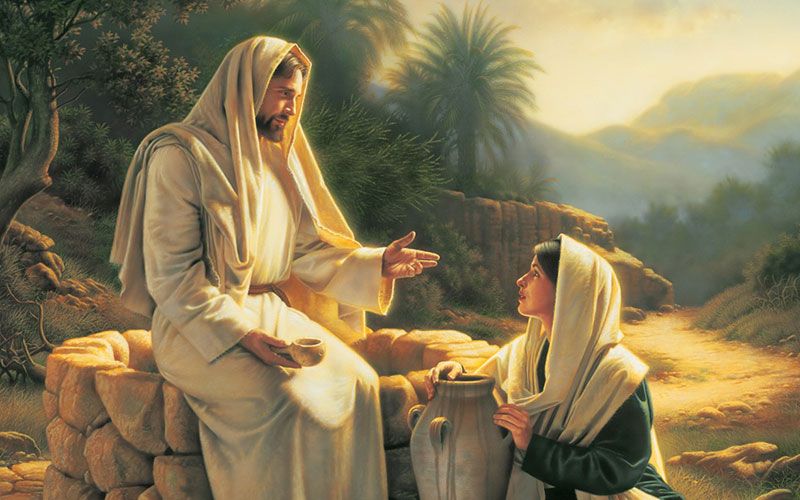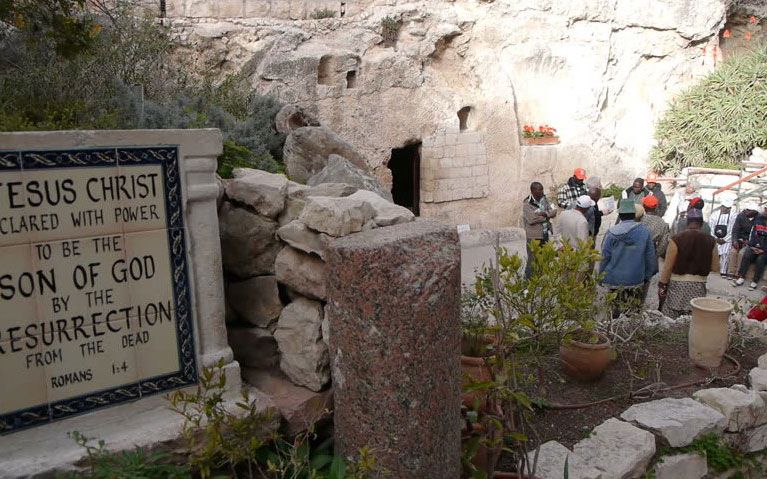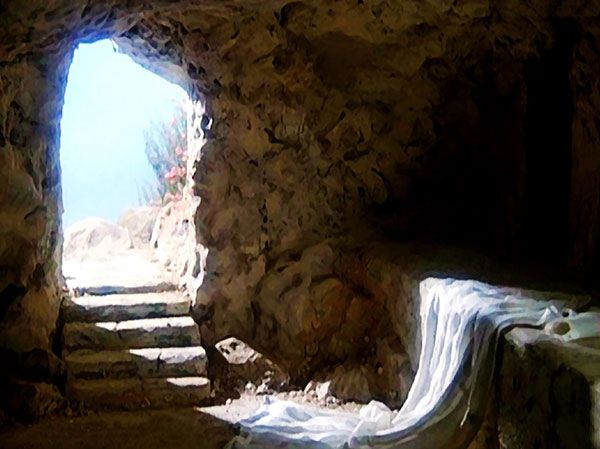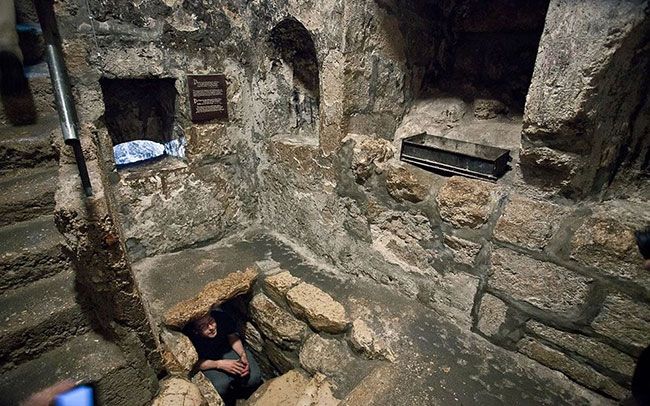Tomb of Jesus reopened after hundreds of years and scientists make fantastic discovery
Israel is home to some of the most revered holy sites in Christianity, but none are considered more important than the Church of the Holy Sepulchre.

Photo: Allbreaknews.com
After centuries of decay and structural damage, scientists finally began a long-awaited renovation of the tomb in October 2016. When they removed a marble slab for the first time in hundreds of years, an unprecedented discovery lay beneath it.
The most significant tomb in Christianity
According to the New Testament account of his death, Jesus' tomb was built near the place of his crucifixion. The structure was built to enclose both his body and the cross on which he died. While the exact burial location hasn't been archaeologically proven, historians know one thing for sure about the current Church of the Holy Sepulchre.
The most significant tomb in Christianity
According to the New Testament account of his death, Jesus' tomb was built near the place of his crucifixion. The structure was built to enclose both his body and the cross on which he died. While the exact burial location hasn't been archaeologically proven, historians know one thing for sure about the current Church of the Holy Sepulchre.
The first church on the site was built by the Roman Emperor Constantine the Great around 326 AD and was meant to house his own burial place. First, Constantine's mother, Helena, was sent to find the exact location of Jesus' tomb from three centuries prior. With the help of a bishop named Eusebius, she believed she had found it.

Photo: Jerusalem – Holy Sepulchre
Early restorations
From the site established by the Emperor Constantine's mother, the Church of the Holy Sepulchre endured for several years, driven by centuries of Crusades. The church's bell tower collapsed in 1545, prompting the first restoration.
The Franciscan friars completed their own renovation of the long-neglected church. This included one of the first cleanings of the edicule: the shrine that housed Jesus' tomb.
Sealing
The Franciscan monks then sealed the burial site in 1555. In order to preserve the site and prevent eager pilgrims from touching the actual rock where Jesus' body once lay, the monks installed a marble slab over the limestone burial.
For centuries, it remained unopened. Archaeologists wanted to dig further into the tomb to see if there was any archaeological evidence that Jesus' body was once there.
Many powers
A modern restoration of the Church of the Holy Sepulchre was long overdue. But implementing changes to this most significant of Christian holy sites is notoriously difficult.
Part of the difficulty stems from the fact that three major Christian denominations – Roman Catholic, Armenian Apostolic, and Greek Orthodox – share custody of the church, and they don't always agree.

Photo: Allbreaknews.com
“The immovable ladder”
For example, a debate raged for two and a half centuries over whether or not to remove a cedarwood ladder above the church's entrance. It has a rather funny history.
The object was affectionately dubbed “the immovable ladder” and is still there today. Differences aside, the priests decided it was time for a cleanup. Little did they know what they would eventually witness.
Planning the renovation and excavation
In 1947, during British colonial rule, an iron scaffold was placed around the Ottoman-style edicule to prevent it from collapsing to the ground. Then came a 2016 project to help preserve this traditional site of Jesus' tomb.
Carried out by a team of scientists from the University of Athens, this restoration would also include an archaeological excavation of Jesus' tomb. They hoped to uncover its most intimate contents.
Unprecedented
The growing field of biblical archaeology aims to reveal the historical truth (or conversely, refute it) of events and places described in the Bible. This was exactly the plan of the 2016 excavation. Modern technology would provide unprecedented access to information that biblical enthusiasts had pondered over for their entire lives.
The main question scientists sought to answer: Was the current tomb in the Church of the Holy Sepulchre truly Jesus' final resting place? But not everything was clear by then.
Lack of evidence
Centuries of wars and natural disasters led scientists to strongly suspect that the edicule did not actually house Jesus' tomb. A few decades after his death, Jerusalem was completely destroyed, ravaged in 70 AD during the First Jewish-Roman War.
To complicate matters further, despite what's written, there's physical evidence for only two Roman crucifixions during Jesus' time (one was found near Jerusalem in 1968, the other in Italy in 2018).
Previous discovery – From excavations conducted in the 1970s, researchers determined that the structure of the Holy Sepulchre was built to enclose the dominant religion that was present before Christianity arrived.
The location that Helena and Eusebius had declared as Jesus' tomb had been a temple for the Roman gods Jupiter or Venus, built by Emperor Hadrian centuries before Constantine's reign.
Earlier expeditions
The leader of the 1970s excavation, a Franciscan priest and archaeologist named Virgilio Canio Corbo, surmised that the church enclosure would be approximately in the same place it was during Hadrian's time.
This meant that the location of the edicule hadn't moved since the 2nd century AD. While Corbo's hypothesis was contested, more evidence fortunately emerged to further support the claim that this was indeed Jesus' tomb site.

Photo: Israel Jerusalem
Outside the city walls?
Additional excavations carried out during the 20th century revealed groundbreaking finds at the Church of the Holy Sepulchre. This included several stone tombs and an ancient limestone quarry believed to be the remains of Constantine's original church from 326, a description supported by the Bible.
These discoveries shed significant light on the accepted location of Jesus' tomb. Another key question was whether the current site would have been inside or outside Jerusalem's walls during Jesus' death.
What the Bible says
As expected, the greatest guide in times of Christian doubt is the Bible. So according to the Bible itself, it's stated that Jesus Christ was buried outside the city walls – but the current church and tomb are within the walls of the Old City of Jerusalem.
But further findings suggested that the church would have been outside the city during the immediate time after Jesus' death, and the walls expanded afterward. So far, many pieces were fitting together.
Getting the green light
These recent findings were taken into consideration when the monks of the Holy Sepulchre decided to allow the Athens team to begin the restoration work. With the team's assurance that the existing structure wouldn't be altered, approval was granted. The work was ready to begin, along with a unique opportunity to see inside Jesus' tomb.
The team took ten months to complete the exterior restorations of the edicule. With careful precision, they manually removed mold and water damage and inserted modern screws to reinforce the walls and foundations. This ensured that the structure would stand solid for at least a few more centuries. But the research team saved the best part of the project for last.
Opening the burial chamber
Remember the marble slab that the Franciscan monks placed over the burial chamber to shield it from millions of pilgrims? The team was about to move it for the first time since it was put there in the mid-16th century. It was a moment of discovery that scientists – and monks – had been waiting for their whole lives.
On October 25 and 26, 2016, the team worked in the Church of the Holy Sepulchre for sixty straight hours to lift the marble slab, taking extra care not to damage any part of the burial chamber around it. When the marble was finally lifted, the team saw something they weren't expecting.
Hidden for centuries
Underneath the marble were several layers of dirt and debris that had accumulated for literally thousands of years. It was the first time humans had laid eyes on the deepest part of the burial chamber, and it might possibly be the last. After hours of excavation, sifting, and debris removal, they made a shocking new discovery.
Scientists had no idea that another marble slab had been placed beneath the one the Franciscan monks placed in 1555. It was a complete surprise. While the first layer of marble was a milky white, the second was gray, a sign of its extraordinary age. On the surface of the gray marble, the team saw something they couldn't believe. There was a beautiful cross engraved in the center of the stone
What did this mean?
What did this mean?
This second, long-hidden marble slab was a mystery that sent historians on a frantic quest for answers. Some speculated that the cross was placed there during the time of the Crusades, a lasting mark of one of their conquests of the Holy City. Some thought it might have been the result of an attack by Arab conquerors even before the Crusades, around 1009.
Still, others suggested it could be even older. Despite a myriad of theories, there was one thing the team agreed on. The newly discovered marble had to be at least as old as the walls surrounding it, which would make it at least five hundred years old. But was there any way to know its age for sure?
Getting the results
The 2016 excavation team used a process called Optically Stimulated Luminescence (OSL) to determine when the material they collected was last exposed to light. This would provide the scientific evidence to prove the chamber's exact date. After nearly a year, the results came in.
Despite prior evidence linking the chamber to the Roman period before they became Christians, the most recent tests proved that the burial slab and the hidden cover had last been exposed during the fourth century. That was the same time period that Constantine built the first Church of the Holy Sepulchre!
More evidence – Further findings could provide a compelling archaeological record throughout the depth of the chamber. Analysis of the mortar taken from the southern wall of the tomb matched the dating of the marble slab and cover. For the Athens team and for the monks who had the opportunity to oversee the work, this was thrilling news.
With the restoration complete, it's unlikely the marble slabs and burial chamber will be opened again anytime in the near future. The excavation results revealed new facts that will forever change how people around the world view Christianity's holiest site. The point resonated widely.
Converting non-believers into believers
Even some of the staunchest critics of the authenticity of Jesus' tomb site have had a change of heart regarding the recent findings, as they provide relevant facts.
The renowned Israeli archaeologist Dan Bahat, who questioned the authenticity of Corbo's claim that the church was approximately in the same location as when it was built almost two thousand years ago, said there is now no reason to doubt the site's authenticity.
No 100% certainty
While there might not be concrete evidence that Jesus' body was actually buried there directly, “we really have no reason to reject the authenticity of the site,”
“Certainly, there are no other sites that can carry such a strong claim.” – Bahat says.
Though the Protestant world and many archaeologists believe the real site was outside the Old City in a place called the Garden Tomb, the findings of the 2016 excavations have convinced more than a few experts.
Why this matters – Undoubtedly, archaeologists and seekers of historical truths will continue to make groundbreaking discoveries that unveil new realities about the physical history behind Bible stories. But for true believers, discoveries like the one made by the Athens team are inconsequential. A trip to Jerusalem is evidence enough.
Once inside the Old City, visitors will see numerous pilgrims rejoicing, weeping, blessing their children, and experiencing their own form of religious epiphanies. For them, the authenticity of the sites is unshakable, and the answers they seek are simply in their faith.




